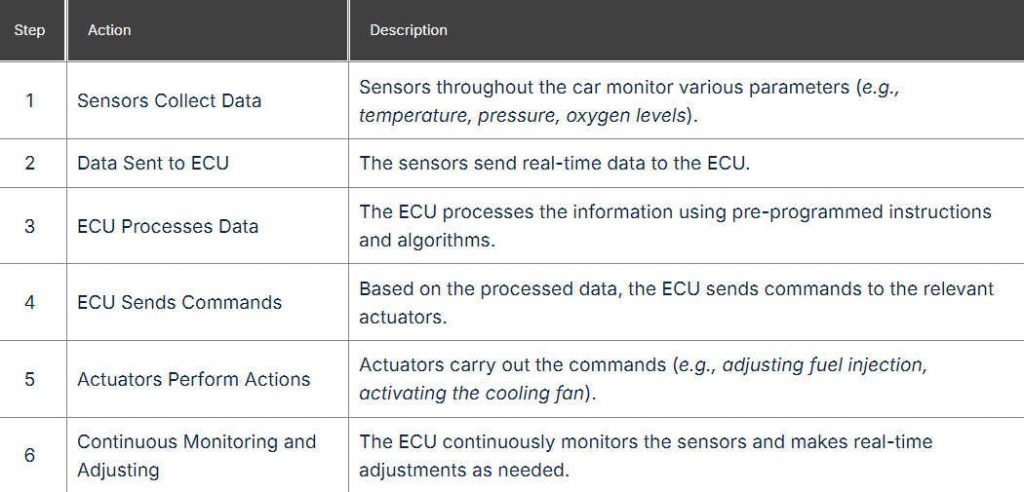What is an ECU in a Car?
An Electronic Control Unit (ECU) is a small but powerful computer inside your car. These units are responsible for controlling various electrical systems and subsystems, making sure your vehicle runs smoothly and efficiently.
While the Engine Control Unit is one type of ECU, managing engine performance, there are many other ECUs in a modern car. They handle everything from window controls to airbags to the infotainment system.
They gather information from various sensors—like those for oxygen, temperature, and pressure—and use this data to make real-time adjustments. This coordination ensures your engine runs efficiently, your safety systems respond quickly, and your car’s climate control and entertainment features work seamlessly.
How an ECU Works
an ECU processes information from various parts of your car and makes real-time decisions to keep everything running smoothly.
the ECU gathers data from numerous sensors located throughout the vehicle. These sensors monitor things like engine temperature, air pressure, oxygen levels, and many other parameters. Think of them as the car’s sensory organs, constantly sending information to the ECU.
the ECU ensures that your car operates efficiently, performs well, and stays safe.To better understand this process, here’s a step-by-step breakdown:

Signs Your Car’s ECU Might be Failing
Car Won’t Start: One of the most obvious signs of a faulty ECU is when your car struggles to start or doesn’t start at all. The ECU plays a crucial role in managing the engine start-up process. If it’s not functioning correctly, it can prevent the engine from firing up.
Check Engine Light is On: The Check Engine light on your dashboard is a catch-all for many issues, but a malfunctioning ECU is one of the potential culprits. If this light comes on and stays on, it’s worth getting your ECU checked.
Engine Misfires or Stalls: If your engine misfires, stalls, or exhibits unpredictable behavior, it could be a sign that the ECU isn’t regulating the engine functions properly. These issues can affect your car’s performance and reliability.
Troubleshooting and Replacing Your ECU Car Part
Understanding ECU Error Codes
When that Check Engine light comes on, it’s your car’s way of telling you something is wrong. The ECU stores error codes that help pinpoint the issue. Here are some common ones:
P0171: System Too Lean (Bank 1) — Your engine is getting too much air or not enough fuel.
P0300: Random/Multiple Cylinder Misfire Detected — Multiple cylinders are misfiring.
P0420: Catalyst System Efficiency Below Threshold — There’s likely an issue with your catalytic converter.
Reading and Interpreting Error Codes
Using an OBD2 scanner can seem tricky, but it’s simpler than you might think. Here’s a quick run-through:
Get an OBD-II Scanner: This tool reads the error codes from your car’s ECU.
Plug in the Scanner: Find the OBD-II port, usually under the dashboard, and connect the scanner.
Retrieve the Codes: Turn on your car and follow the scanner’s instructions to get the error codes.
Look Up the Codes: Use the scanner’s manual or an online database to understand what each code means.
Tools you may need:



